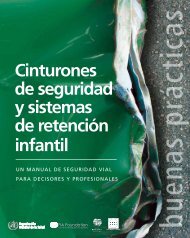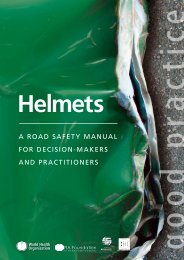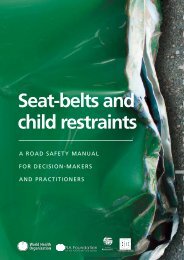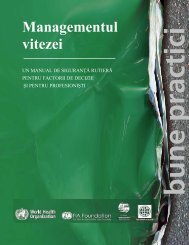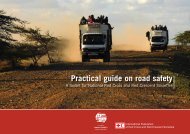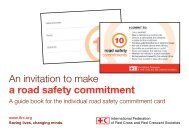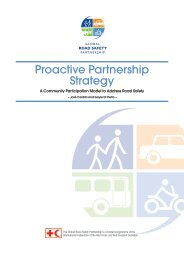How to design and implement a drinking and driving programme pdf ...
How to design and implement a drinking and driving programme pdf ...
How to design and implement a drinking and driving programme pdf ...
You also want an ePaper? Increase the reach of your titles
YUMPU automatically turns print PDFs into web optimized ePapers that Google loves.
Drinking <strong>and</strong> Driving: a road safety manual<br />
BOX 3.14: Ensuring that the emergency medical services are prepared<br />
Setting up an EMS system may not be feasible for<br />
many countries, but alternative pre-hospital care<br />
arrangements can be developed.<br />
Trauma care, in both pre-hospital <strong>and</strong> hospital settings,<br />
requires speedy <strong>and</strong> appropriate action by<br />
trained personnel, with proper supplies <strong>and</strong> equipment.<br />
Improving trauma systems has been shown<br />
<strong>to</strong> lower the mortality in all treated trauma patients<br />
by between 15% <strong>and</strong> 20%, <strong>and</strong> <strong>to</strong> cut the number of<br />
preventable deaths by more than 50%.<br />
Several recent publications provide technical details<br />
of on how <strong>to</strong> improve trauma care. Two, published<br />
by WHO, are strongly recommended: Guidelines for<br />
essential trauma care (24) <strong>and</strong> Pre-hospital trauma<br />
care systems (25).<br />
Pre-hospital care<br />
The pre-hospital stage is an important one <strong>to</strong><br />
target in efforts <strong>to</strong> cut the number of road traffic<br />
deaths. The care given will depend on the services<br />
that exist.<br />
Situations where no formal emergency medical service<br />
exists<br />
A “formal” system of emergency medical services<br />
(EMS) is usually one with ambulances <strong>and</strong> trained<br />
personnel, who work in an agency with some supervision<br />
<strong>and</strong> with a network of communications. Where<br />
no formal EMS exists, governments should make<br />
alternative arrangements <strong>to</strong> provide pre-hospital<br />
care. Ways can be found <strong>to</strong> build on existing, informal<br />
systems <strong>and</strong> harness community resources,<br />
such as training members of the public in basic first<br />
aid. Setting up formal EMS systems in urban areas<br />
<strong>and</strong> along major inter-urban roadways should also<br />
be explored. Cost should be one consideration,<br />
given the high cost of these systems.<br />
Strengthening existing EMS systems<br />
Many EMS systems could be strengthened in a<br />
number of ways, for example, by establishing a<br />
regula<strong>to</strong>ry agency <strong>to</strong> promote minimum st<strong>and</strong>ards<br />
for the delivery of prompt, quality <strong>and</strong> equitable<br />
pre-hospital care. They can also be strengthened by<br />
streamlining communication between sites where<br />
calls are received (such as alarm centres) <strong>and</strong> the<br />
sites of ambulance dispatch, as well as between<br />
different ambulance services; <strong>and</strong> by keeping good<br />
records on people cared for by the EMS, so as <strong>to</strong><br />
moni<strong>to</strong>r <strong>and</strong> improve the quality of care.<br />
Essential trauma care<br />
Improvements in trauma care need not necessarily<br />
involve high-cost, high-technology equipment. Much<br />
can be accomplished in an affordable <strong>and</strong> sustainable<br />
way through better planning <strong>and</strong> organization.<br />
The essential trauma care services <strong>and</strong> the<br />
resources required for them can be promoted in several<br />
ways, including through needs assessments<br />
of trauma care requirements, through training in<br />
trauma care provided in appropriate educational<br />
settings, through quality improvement <strong>programme</strong>s<br />
that consider the entire trauma facility setting, <strong>and</strong><br />
through the inspection of trauma facilities (24).<br />
Rehabilitation<br />
Many of those who survive injury go on <strong>to</strong> develop<br />
physical disabilities that limit their physical functions.<br />
Tragically, many of these consequences<br />
are avoidable <strong>and</strong> can be reduced through better<br />
rehabilitation services. Rehabilitation services are<br />
an essential element of trauma care, <strong>and</strong> can be<br />
improved by conducting in-depth needs assessments<br />
for injury-related rehabilitation <strong>and</strong> by<br />
strengthening national rehabilitation <strong>programme</strong>s.<br />
They can also be improved by incorporating the<br />
recommendations of World Health Assembly Resolution<br />
WHA58.23 <strong>and</strong> the recommendations on<br />
rehabilitation in the Guidelines for Essential Trauma<br />
Care (24) in<strong>to</strong> a country’s health policy.<br />
3 | <strong>How</strong> <strong>to</strong> <strong>design</strong> <strong>and</strong> <strong>implement</strong> a <strong>drinking</strong> <strong>and</strong> <strong>driving</strong> <strong>programme</strong><br />
115



